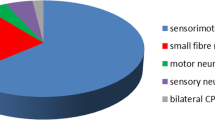Abstract
Amyloid neuropathies occur in a context of hereditary (FAP) or acquired amyloidosis. They present usually as severe and progressive polyneuropathy and carry a poor prognosis. Most FAP are associated with endoneurial deposits of variant transthyretin (TTR) with substitution of one aminoacid and are secondary to a point mutation of the TTR gene. Portugal is the main endemic area of TTR-FAP, secondary to point mutation of exon 2. However, around the world, 50 other TTR gene mutations have been recently reported, each one in few families. Genetic studies are useful for diagnosis of FAP in patients with a positive family history and for identification of the cause of seemingly sporadic cases. TTR gene analysis is also useful for genetic counselling including antenatal diagnosis in variants with early onset. Gelsolin-FAP are the second variety and present as a benign cranial and sensory polyneuropathy and affect essentially Finnish patients. Acquired amyloid neuropathy concerns only immunoglobulin light chain amyloidosis (AL) and are frequently associated with renal manifestations and monoclonal protein in serum or urine. Specific treatment of amyloid polyneuropathy varies with the variety of amyloidosis including liver transplantation in TTR-FAP, at the onset of the disease or chemotherapy for immunoglobulin light chain amyloidosis.
Similar content being viewed by others
Author information
Authors and Affiliations
Additional information
Received: 8 March 2001 / Accepted: 12 March 2001
Rights and permissions
About this article
Cite this article
Adams, D. Hereditary and acquired amyloid neuropathies. J Neurol 248, 647–657 (2001). https://doi.org/10.1007/s004150170109
Issue Date:
DOI: https://doi.org/10.1007/s004150170109




